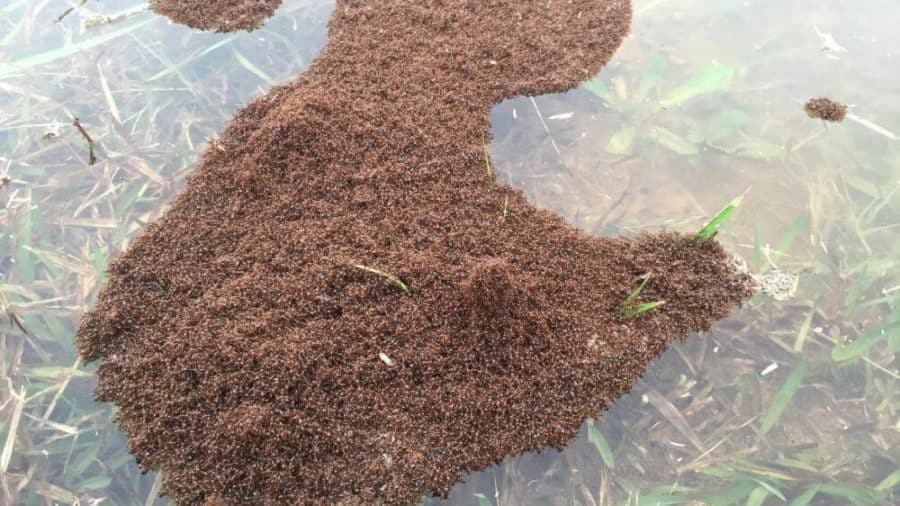“Life likes to live,” Kevin Haight said after viewing a photo of reddish-brown swirls in a floodwater eddy in southeast Texas.
Haight, a researcher in the School of Life Sciences’ Social Insect Research Group at Arizona State University, was referring to tens of thousands of refugees uprooted by Hurricane Harvey.
Just not the ones you think.
The nation (or at least the media, both social and traditional) has been transfixed by the spectacle of floating rafts of fire ants drifting through Houston’s floodwaters.
“Nightmarish.” “Creepy.” “Stuff of the Book of Revelations.”
There is a complex and fascinating story behind this survival behavior, however, one that evokes more sympathy than revulsion. You still won’t want to bump into a fire-ant raft after you hear it, but you will stare in fascination if you’re lucky enough to see one.
Fire ants sting. There is a scale called the Schmidt Pain Index that attempts to systematize pain from insect venom. Created by an Arizona entomologist, it goes from pain level 1 (“a lover just bit your earlobe a little too hard”) to pain level 4 (“blinding, fierce [and] shockingly electric”).
A single fire-ant sting rates a 1.2, with a honeybee sting rating a 2.
“However, that is for just for a single sting, which is not common to experience with (fire ants),” Haight said. “Multiple stings from multiple workers are much more usual.
“Furthermore, (fire-ant) venom not only causes pain, which is felt almost immediately, but also causes tissue damage in the form of little pustules, which become evident hours to days after being stung and can lead to secondary infection if opened.”
Here’s the kicker: Their stings become significantly more painful and venomous when they’re rafting. How much more painful? Eighty-seven percent, according to Haight. He published a paper in 2006 describing his discovery, which to his amusement is now getting a great deal of attention.
Why are their stings more painful? It’s simple: They are at their most defenseless, and the survival of the colony is on the line.
Here’s what goes on:
As the water table rises in the nest, the ants concentrate as dry space dwindles. As they do that, they gather the queen and brood (the eggs, larvae, pupae, workers). They’re becoming what people would refer to as “stressed.”
“The close proximity of so many workers during rafting may result in a concomitantly higher concentration of alarm pheromones, and thus the increase in defensiveness,” Haight wrote in his paper.
The water continues to rise. Now they float in the water above their nest.
They have some food with them. Their crop contains sugary liquids they can share with larvae and each other. (Fire ants do stash “ant jerky” in their nests — dried protein flakes — but they don’t carry it with them in a flood. As Haight pointed out, “If your house is on fire, what are you going to do — empty the fridge or grab your kids?”)
They’re floating, and they hold on to each other. They cycle from the bottom of the raft to the top in a convection pattern. The rafts are more buoyant if they have larvae, research has shown.
They are completely at the mercy of the current.
“They are a rudderless boat,” Haight said. “They have no control over where they end up. Typically it’s downstream.”
Now the ants are at their most dangerous. Large concentrations of workers are exposed, available for defense, and loaded with more potent venom. They’re also on high alert to grab on to something, anything, and get out of the water.
“If they bump against a tree branch or something in the water, they’ll do that,” Haight said. “It’s one of the things that makes them dangerous in a flood situation when you have people wading or people in boats. If the ants bump up against a boat and they’re able to climb up the sides, then they’re in the boat with you now.”
When they hit dry ground, they will begin digging a new nest. They are incredibly efficient diggers. Depending on how hard the ground is, they can dig a new nest and get the whole colony underground in five to six hours, Haight said.
“They’re never more vulnerable than when they’re rafting,” he said. “They have no place to go. They can’t go deeper in their nest because they don’t have a nest.”
Animals or people trudging through water could break the colony up, or predators like fish. The colony could perish. Without a big workforce, survival becomes dicey. Increasingly painful stings increase the likelihood of survival.
“I would argue that yes, it is an adaptive survival mechanism,” Haight said. “Higher venom doses mean more pain delivered to a threat in a shorter amount of time, which translates to higher repellency. This would be especially important to a rafting colony since quick repulsion would reduce the chances of worker loss, which would be beneficial since colonies with more workers will have a higher chance of reestablishing a successful nest and territory after the flood recedes.”
If our reporting has informed or inspired you, please consider making a donation. Every contribution, no matter the size, empowers us to continue delivering accurate, engaging, and trustworthy science and medical news. Independent journalism requires time, effort, and resources—your support ensures we can keep uncovering the stories that matter most to you.
Join us in making knowledge accessible and impactful. Thank you for standing with us!

